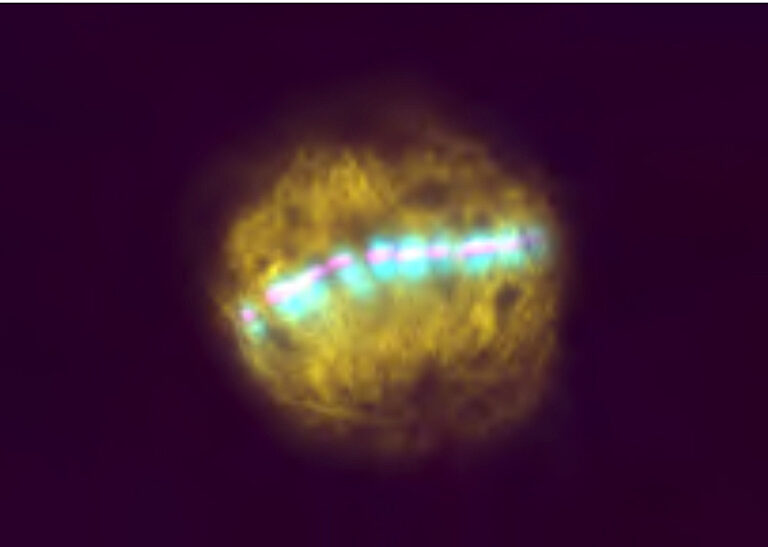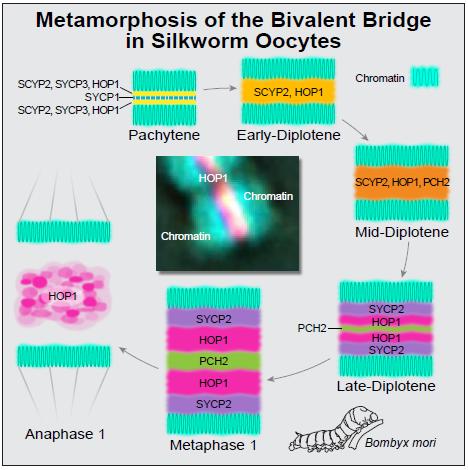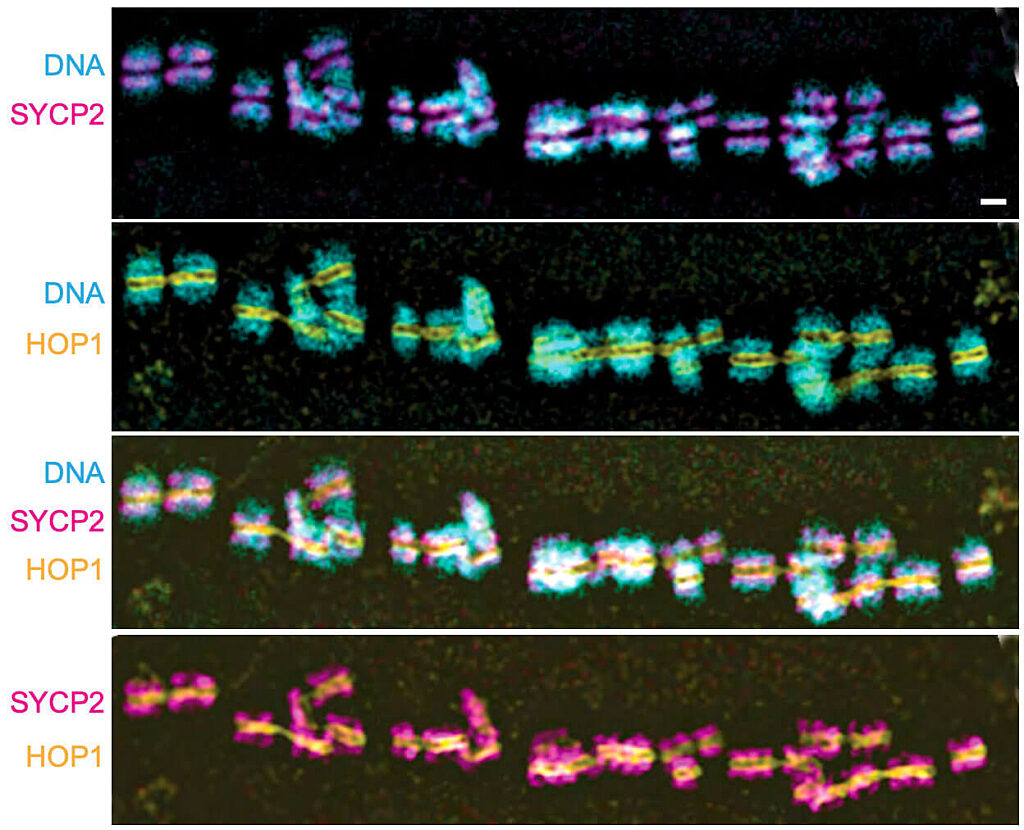News

01 February 2021
Hawley Lab brings silkworms to Stowers
The silkworm is one of the most well-studied lepidopteran model systems worldwide, and a recent arrival in the Hawley Lab at the Stowers Institute for Medical Research.
Read Article
News
A different meiotic mechanism, likely common to all female species of moths and butterflies, holds chromosomes together until they are ready to segregate.

Fluorescent microscopy image of female silkworm egg arrested in metaphase I. Chromosome pairs are aligned in the center of the cell with DNA (cyan), recycled synaptonemal complex protein (magenta), and proteins responsible for separating chromosomes (yellow). Image courtesy of the Hawley Lab, Stowers Institute for Medical Research.
By Rachel Scanza, Ph.D.
Silkworms, furry white caterpillars that mature into moths, produce a prized commodity: silk. Along with their utility to the textile industry, new research from the Stowers Institute for Medical Research is revealing that silkworms are also valuable for understanding unusual biology behind sexual reproduction.
All sexually reproducing species undergo meiosis, the precisely orchestrated cell division process that generates sperm and eggs. While meiosis involves the same steps for most organisms, female butterflies and moths do it differently. A new study published in Current Biology on January 3, 2024, from the lab of Investigator Scott Hawley, Ph.D., characterized the structure that acts to link chromosomes in female silkworm eggs in unprecedented detail.
“There is nothing that Nature does just one way,” explained Hawley. “This is a really major change from what we call the central dogma of meiosis, which is that chromosomes pair, they crossover, and they segregate.”
When homologous chromosomes—one maternal and one paternal—pair up in preparation for cell division, a large assembly of proteins called the synaptonemal complex forms between them. This complex facilitates the exchange or swap of genetic material via a physical linkage called a crossover.

Graphical abstract illustrating the dynamic structure of the Bivalent Bridge that forms in female silkworm eggs. Image courtesy of Mark Miller, Stowers Institute for Medical Research.
The research led by Youbin Xiang, Ph.D., a senior research specialist in the Hawley Lab, found that the chromosomes of female silkworms, which do not crossover, are instead held together by a very different and elaborate protein structure. The team assigned a name for this structure—the Bivalent Bridge.
“It was thought to be just a glob,” said Hawley. “We have identified its components, its structure, and provided real insights into its function, or how it actually works. And, we have now brought silkworms into the fold.”
During early meiosis, female silkworms initially form a synaptonemal complex, which primes their chromosomes for linkages or crossovers. When crossing over does not occur, the complex is dismantled and many of its proteins are recycled and repurposed to construct the Bivalent Bridge. This different meiotic process is likely common to all species of moths and butterflies for holding chromosomes together until they are ready to segregate.
“Forming the synaptonemal complex is a good way to stabilize the initial chromosome pairing,” said Hawley. “When crossovers are supposed to take over to link and orient the pairs, Nature had to evolve quickly to avoid a catastrophic failure of meiosis.”

Fluorescent microscopy images of all 28 bivalents (chromosome pairs) at metaphase I stained with DAPI (DNA, blue), SYCP2 (magenta) and HOP1 (yellow). SYCP2 and HOP1 are recycled and repurposed synaptonemal complex proteins now constructing the Bivalent Bridge. Image courtesy of the Hawley Lab, Stowers Institute for Medical Research.
Although crossovers increase genetic diversity in offspring—chromosomes at the end of meiosis have unique combinations of DNA—organisms with a large number of chromosomes can achieve diversity through independent assortment, or the random segregation of chromosomes to each new cell.
When caterpillars become moths, their lifespan is limited solely to reproduction. After emerging from their silk-spun cocoons, they have no mouth or digestive system, just a reproductive system. “Their only responsibility is to mate and lay those eggs,” said Hawley. And because silk is a valuable material in Asian countries like China and Japan, many scientists and labs there are dedicated to studying the biology of silkworms.
“In China there are entire institutes devoted to silkworms,” said Hawley. “Some study their biology to find ways to increase silk production. Others study foundational biology for comparative or evolutionary insight, yet only two or three labs do so in the U.S.”
Silkworms have found a way to recycle proteins to build a structure that can ensure their chromosomes are able to segregate properly. This bridge-like structure is complex, dynamic, and a fundamentally different mechanism for meiosis.
Hawley recounted a quote from renowned biologist Rochelle Esposito, Ph.D.: “Evolution is not going for a pretty or even sensible solution; all it cares about is that it works.” He continued, “The only question evolution is asking is, ‘Can I make progeny that survive?’”
Additional authors include Dai Tsuchiya, Ph.D., Zulin Yu, Ph.D., Xia Zhao, Ph.D., Sean McKinney, Ph.D., Jay Unruh, Ph.D., Brian Slaughter, Ph.D., and Cathleen M. Lake, Ph.D.
This work was funded by institutional support from the Stowers Institute for Medical Research.
News

01 February 2021
The silkworm is one of the most well-studied lepidopteran model systems worldwide, and a recent arrival in the Hawley Lab at the Stowers Institute for Medical Research.
Read Article
Press Release
20 October 2023
Stowers scientists collaborate to uncover one underlying reason for male infertility
Read Article
Press Release
04 May 2023
Offers unique opportunity to study similar chromosomes linked to cancer and infertility in humans
Read Article
